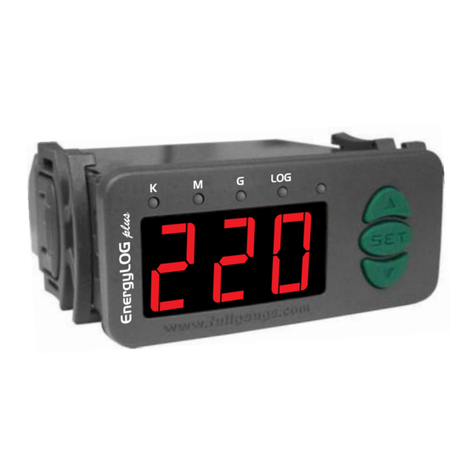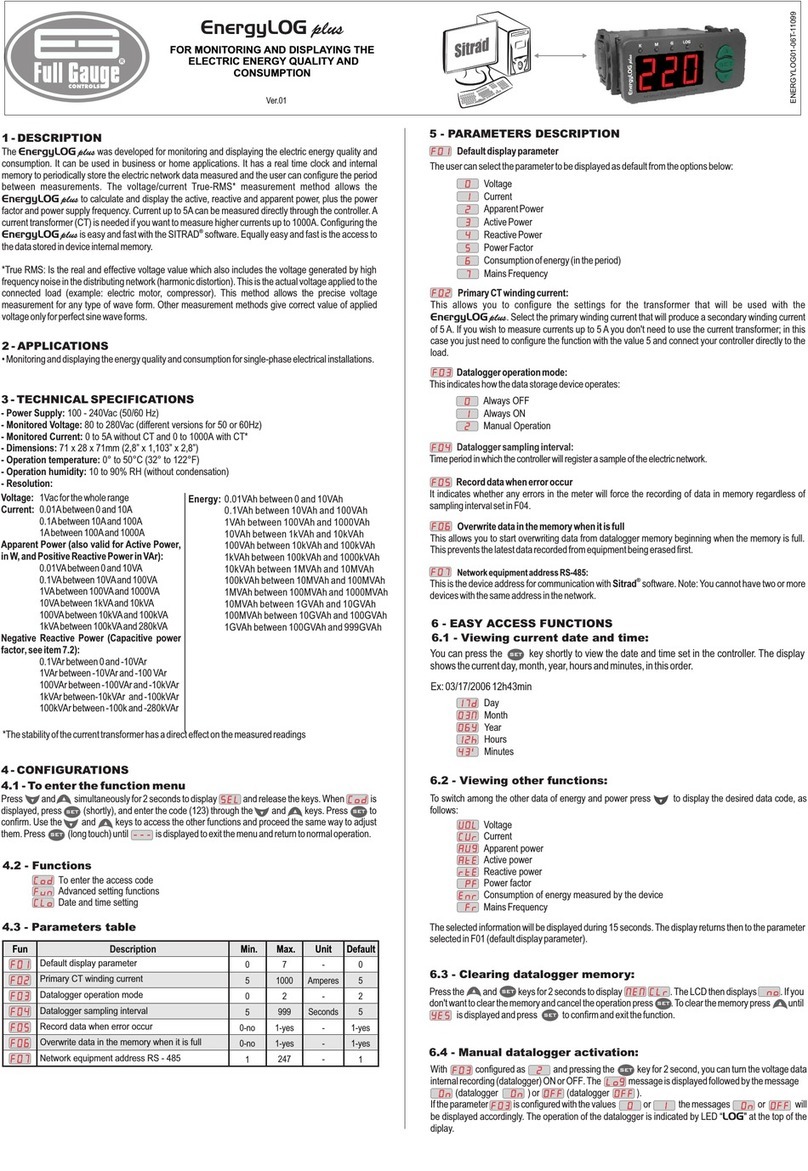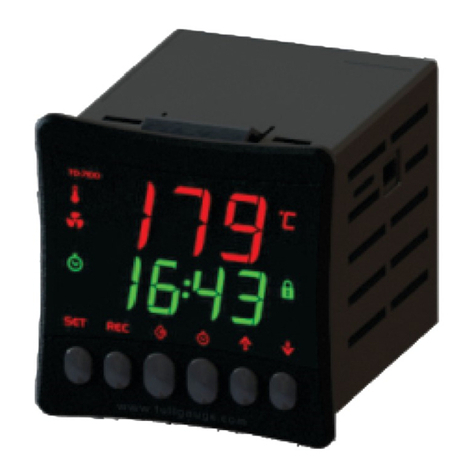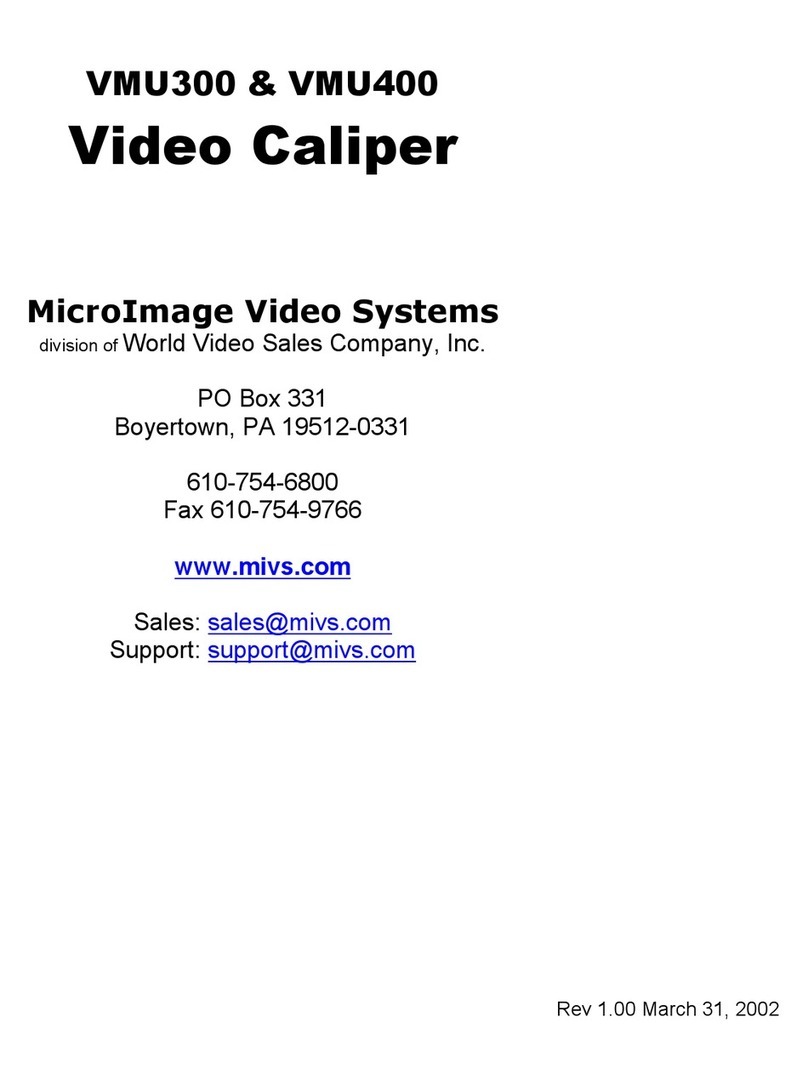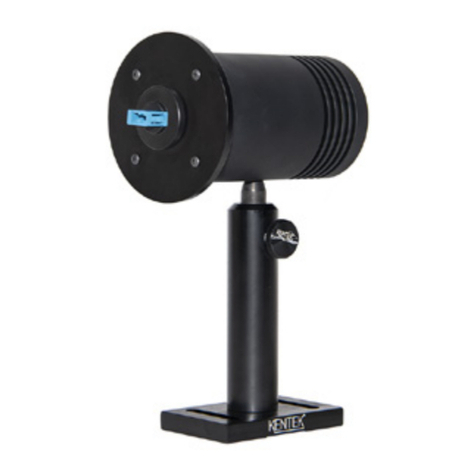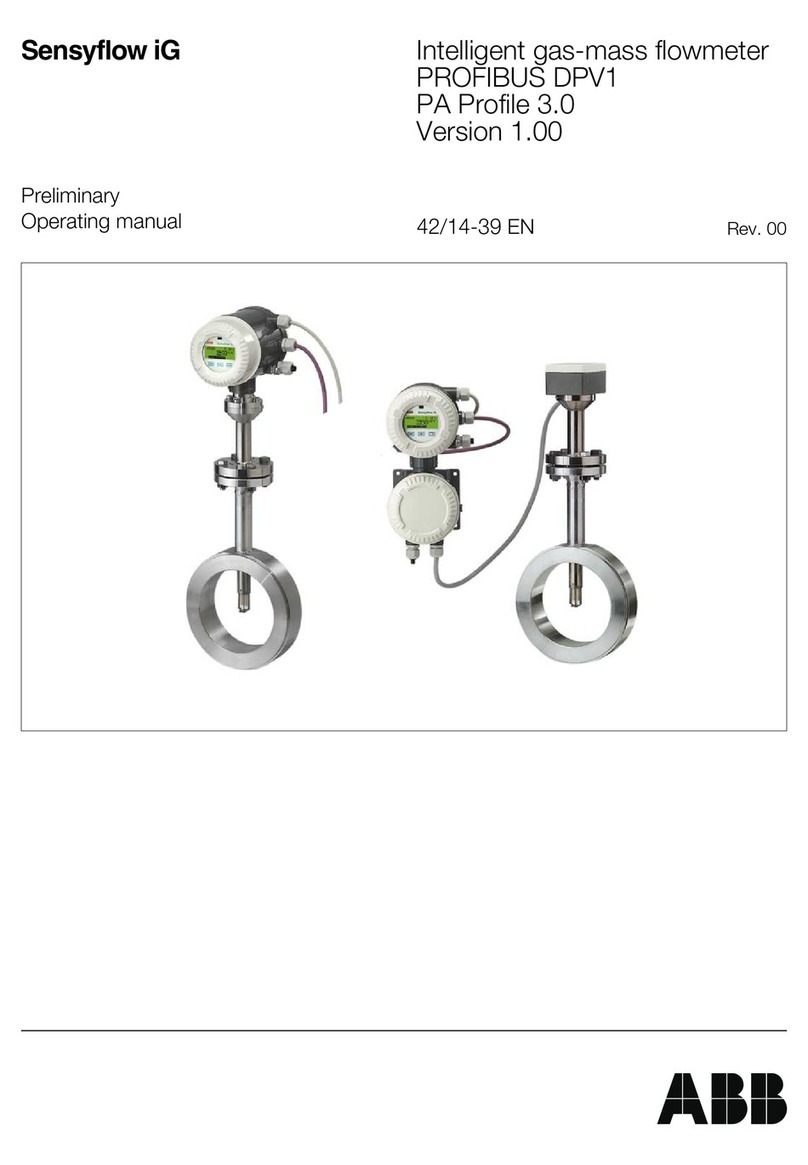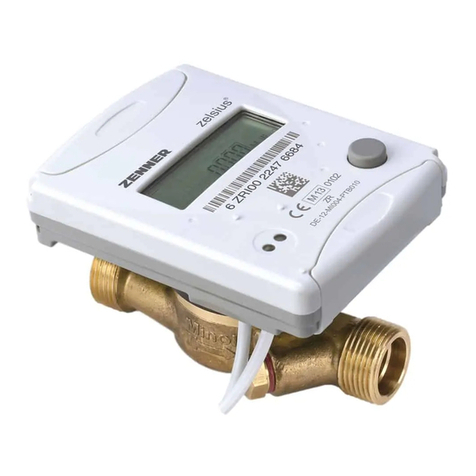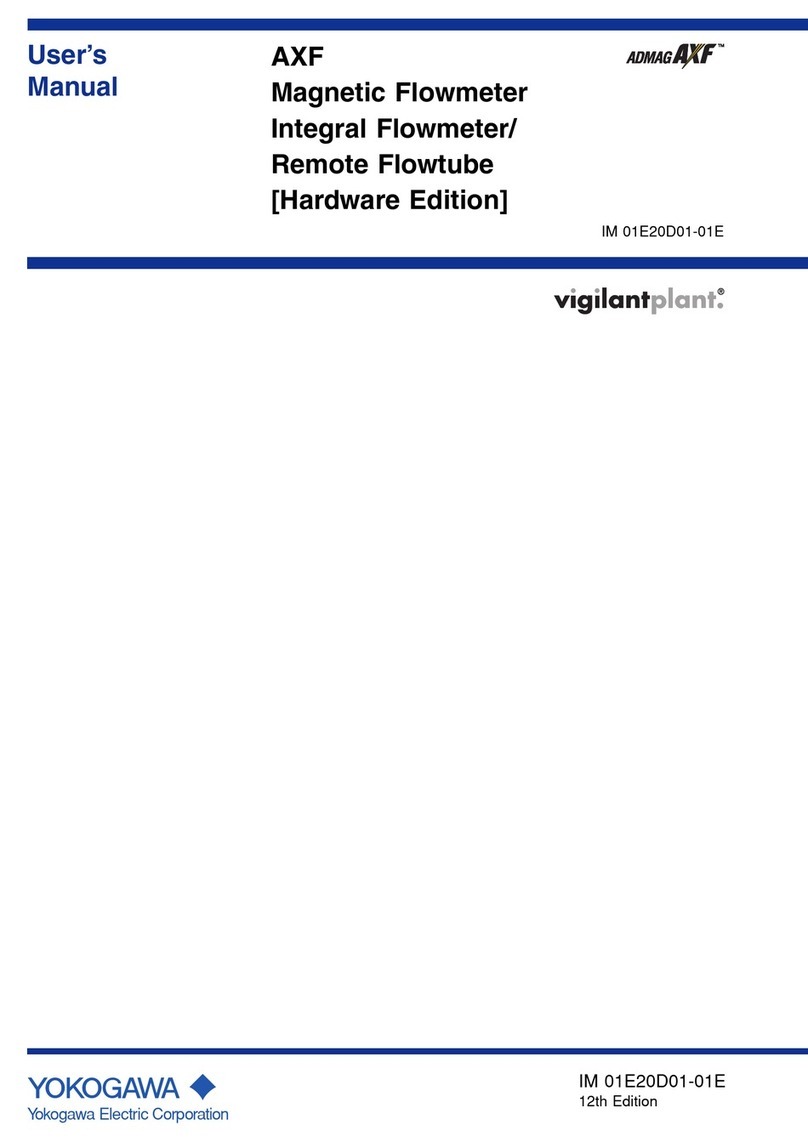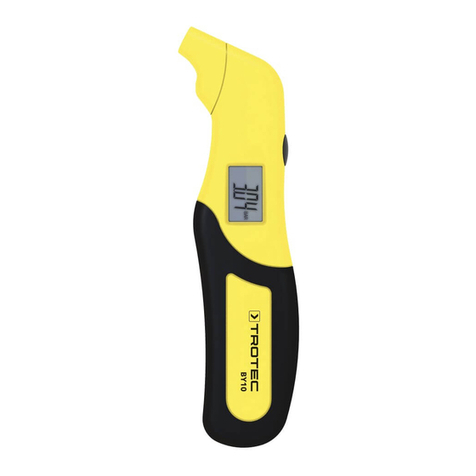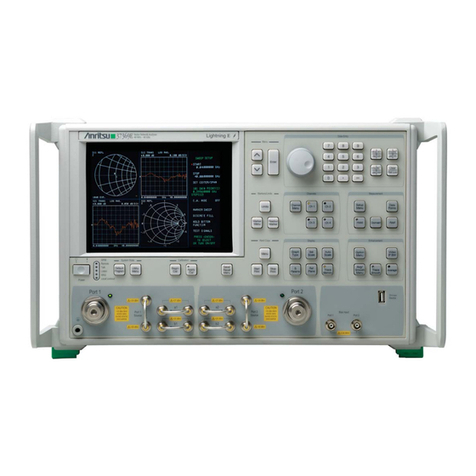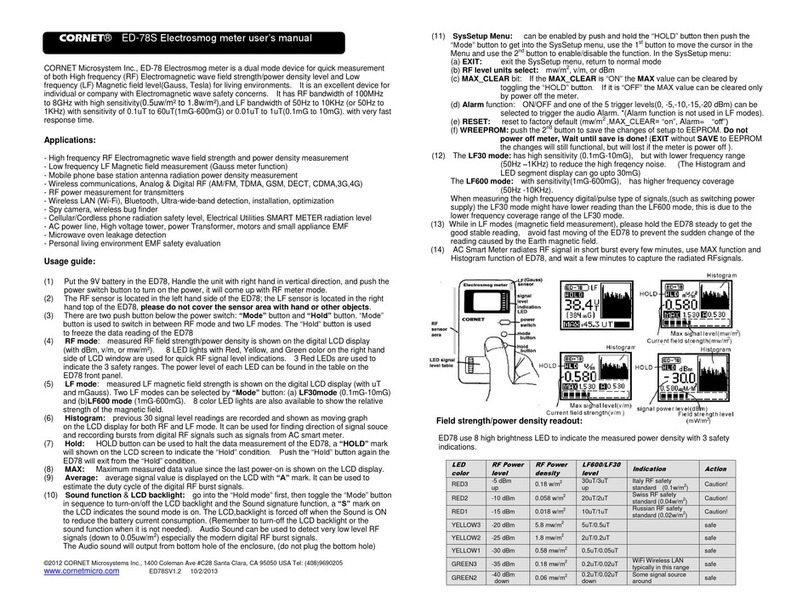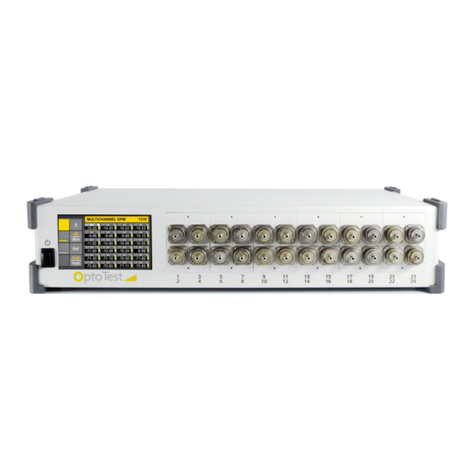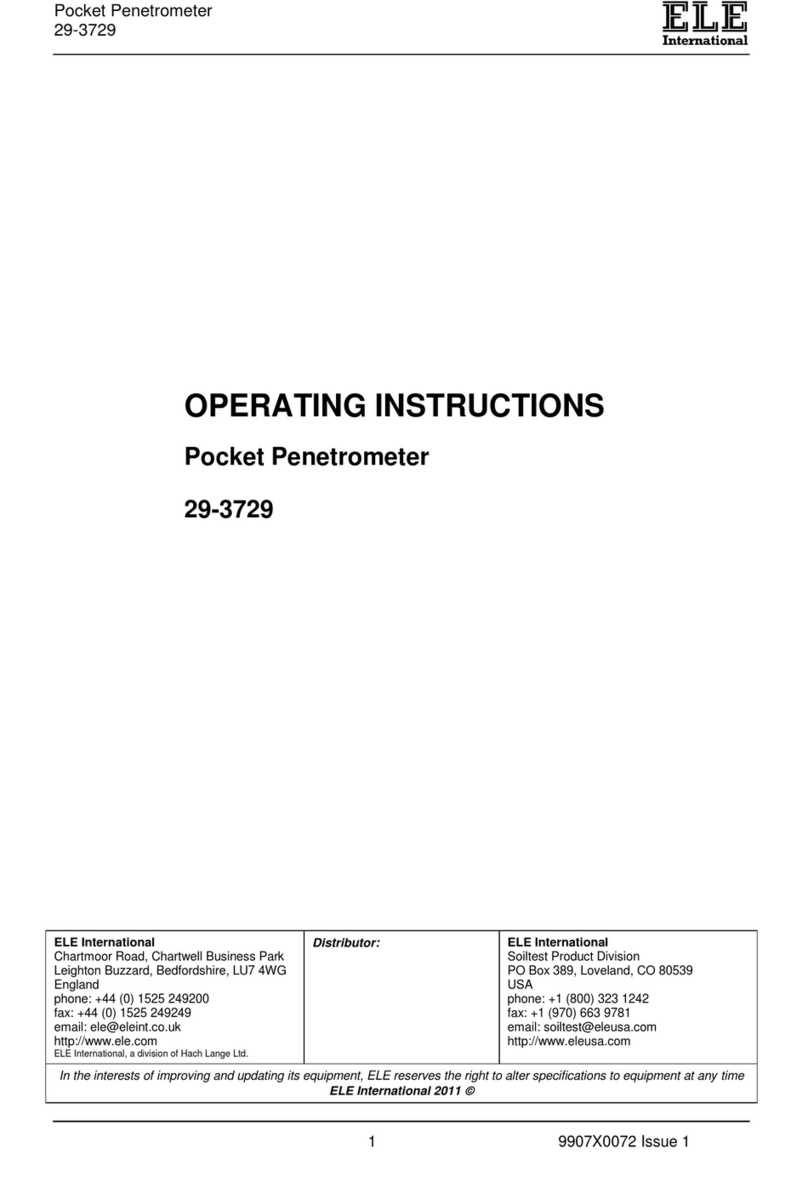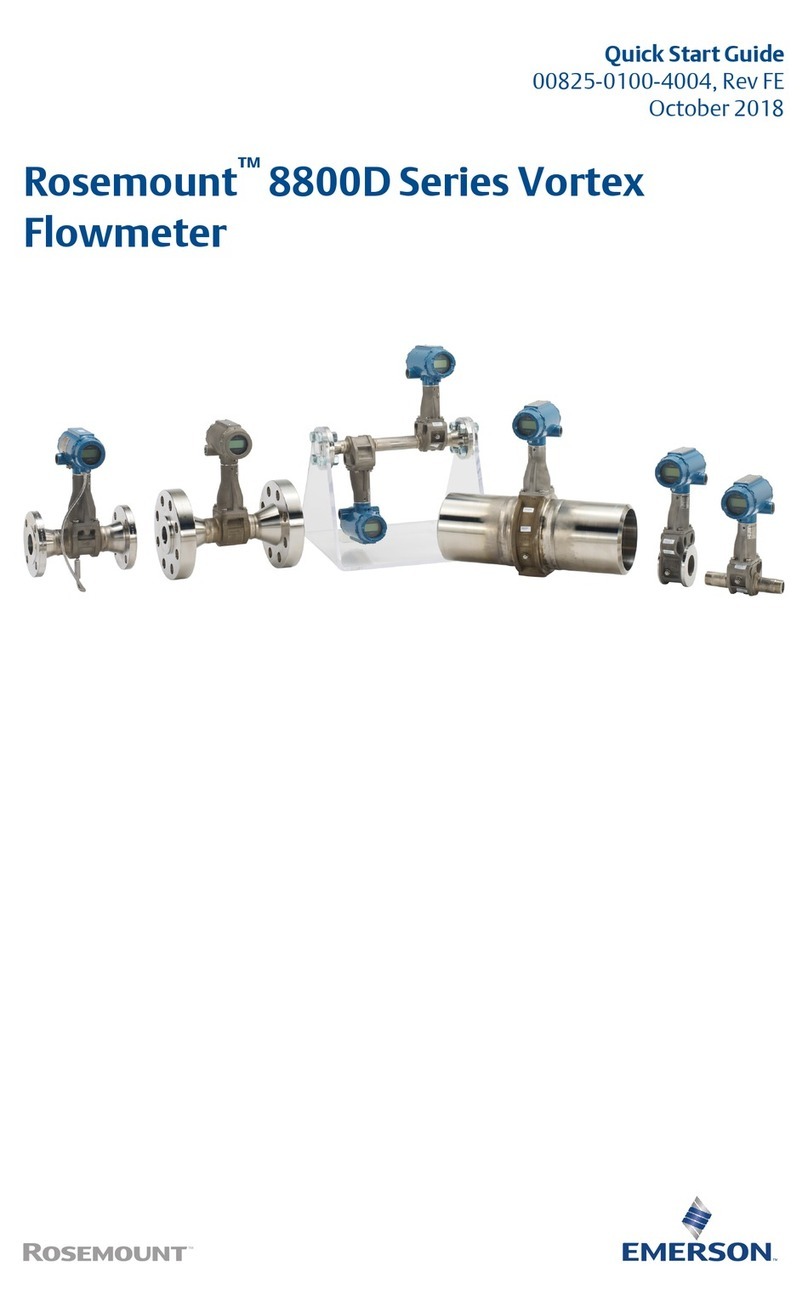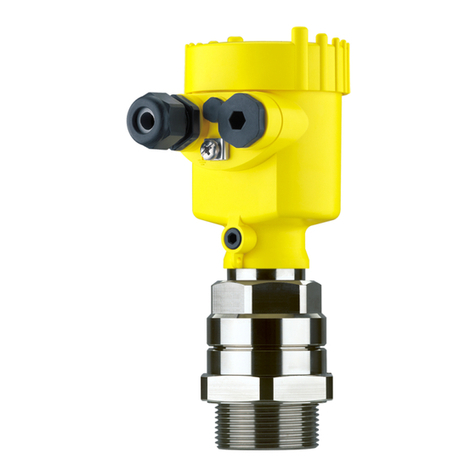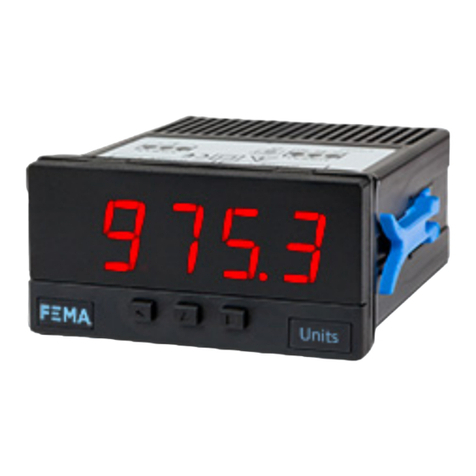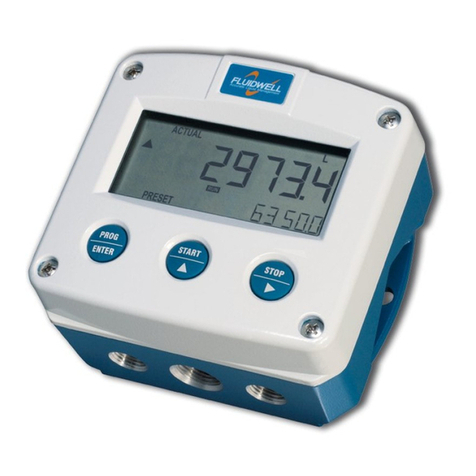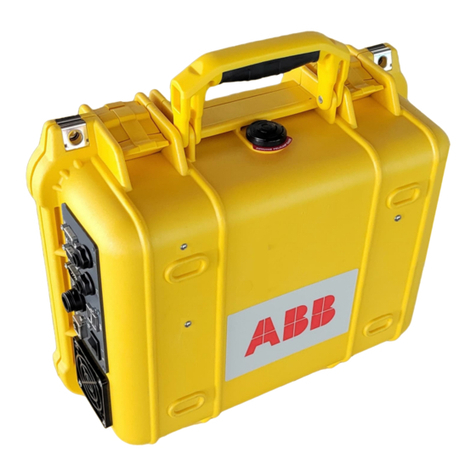Full Gauge Controls PCT-120E plus User manual

PCT120EV01-01T-17613
6. OPERATIONS
6.1 Quick Access Menu Map
To access or browse the quick access menu, use the ;key (quick touch) while the controller is displaying the pressure.
Each touch displays the next function in the list; to confirm, use the /key (quick touch)
1. DESCRIPTION
The PCT-120e plus is an easy to install and operate two-stage pressure controller designed for
systems that require effective pressure control. Operating in pressurization, despressurization,
refrigeration, heating or alarm mode, it directly controls loads of up to 1HP. It also has digital inputs that
allow external devices to be used for protecting the controller system, hourmeters that store the number
of hours compressors/pumps are operating and indicate when maintanance should be performed on
them. Operating in combination with temperature sensors, it also performs dynamic and adiabatic
condensation control, dynamic evaporation, superheating and subcooling monitoring, promoting
greater energy efficiency in the system. It also has serial output for communication with Sitrad and an
intelligent locking function, preventing unauthorized persons from changing the control parameters.
2. APPLICATIONS
• Control over suction or discharge in refrigeration systems, air compressors, semi-artesian pumps,
water tanks and filters, superheating and subcooling monitoring.
evolution
DIGITAL PRESSURE CONTROLLER
AND INDICATOR
Ver.01
PCT-120e plus
PCT-120e plus PCT-120el plus 12v
PCT-120el plus 24v
5. INSTALLATIONS - PANEL AND ELECTRIC CONNECTIONS
3. TECHNICAL SPECIFICATIONS
71 mm± 0,5
(2,80 0,01'’)±
29 mm± 0,5
(1,14 ± 0,01'’)
Panel (front view)
Panel
(side view)
Dimensions of the clip
for fixing the instrument
WARNING
FOR INSTALLATIONS THAT REQUIRE WATER TIGHTNESS, THE OPENING TO INSTALL THE CONTROLLER MUST BE 71,5 x 29,5 mm
(28,15 x 11,6 in) MAXIMUM. THE SIDE LATCHES MUST BE FIXED SO THAT THEY PRESS THE SEALING GASKET TO PREVENT
INFILTRATION BETWEEN THE OPENING AND THE CONTROLLER.
IMPORTANT
2.4 mm (3/32'') SLOTTED SCREWDRIVER FOR ADJUSTMENTS IN THE SIGNAL TERMINALS;
PHILLIPS SCREWDRIVER #1 FOR ADJUSTMENTS AT THE POWER TERMINALS.
IT IS ESSENTIAL TO USE THE CORRECT TOOLS IN ORDER TO AVOID DAMAGES TO THE INSTRUMENT'S CONNECTION
TERMINALS:
Have this manualin your hands
using the FG Finder app.
PRESSURE ADJUSTMENT
(SETPOINT)
;
;
DIFFERENTIAL ADJUSTMENT
(HYSTERESIS)
;
;
HOURMETER VIEW
RESET OF THE HOURMETER
;
;
CONTROL FUNCTIONS
(ON/OFF)
FUNCTIONS LOCK
FUNCTION SELECTION
;
EXIT FUNCTION
;
Configurable dry contact
Pressure resolution
Temperature control range
Approximate consumption
1 psi / 0,1 bar
Temperature resolution 0,1°C / 1°F
-50 to 200°C / -58 to 392°F
Power supply
Water level resolution
Operating temperature
Maximum current
Operating humidity
Product dimensions
Digital Inputs
0,1 mwc
0 to 60°C / 32 to 140°F
10 to 90% UR (no condensation)
76 x 34 x 77 mm (W x H x D) (2,99 x 1,33 x 3,03'’)
IP 65 (frontal)
Protection level
Dimensions of the clip for fixing the instrument
71 0,5 x 29 0,5 mm (2,80 x 0,01 x 1,14 x 0,01'’)
Pressure control range
Water level control range
Sensors available for acquisition
PCT-120E Plus:
PCT-120EL Plus 12Vac/dc:
PCT-120EL Plus 24Vac/dc:
90~240Vac (50/60 Hz)
12Vac/dc 10% (50/60 Hz)
24Vac/dc 10% (50/60 Hz)
±±
-14 to 850 psi / -1 to 58.6 bar (configurable sensor
operating range)
0 to 250 mwc (configurable sensor operating range)
OUT1: 16A / 1HP 250Vac
OUT2: 16A / 1HP 250Vac
SB69 - 100A* (0 to 100 psi / 0 to 6,9 bar)
SB69 - 200A* (0 to 200 psi / 0 to 13,8 bar)
SB69 - 500A* (0 to 500 psi / 0 to 34,4 bar)
SB69 - 850A* (0 to 850 psi / 0 to 58,7 bar)
SB70* - (-50 to 105°C / -58 to 221°F)
SB59* - (-50 to 200°C / -58 to 392°F)
*Sensors sold separately
PCT-120e plus
PCT-120e plus
5.1INSTALLATION - ELECTRIC CONNECTIONS
4VA
±
4. INDICATORS AND KEYS
Led indicator (pressure units: psi/bar)
PCT-120e plus
Upper key
Lower key
Set key
Quick Access
Menu key
Temperature unit indication LED
Water level unit indication LED (mwc)
Led indicator (output 2 on/off)
Led indicator (output 1 on/off)
P B
2m
Control
Functions
Shutdown
Functions
Lock
Serial
Programming
Protection
Level
IP 65
FRONT
Hourmeter Supervisory
System
Electrical connection of pressure
sensors:
Brown: 12 Vdc
Green or White: 4~20 mA
Electrical connection of temperature
sensors/digital inputs:
D1/T1: Pins 4-8
D2/T2: Pins 7-8
GREEN OR WHITE
GREEN OR WHITE
GREEN OR WHITE
GREEN OR WHITE
BROWN
BROWN
GREEN OR WHITE
GREEN OR WHITE
BROWN
+12VDC
+12VDC
+12VDC
D1/T1
D1/T1
D1/T1
D2/T2
D2/T2
GND
GND
12Vac/dc
24Vac/dc
Power supply
Power supply
SITRAD
SITRAD
D2/T2
P1
P1
P1
P2
P2
P2
SITRAD
GND
90~240Vac
16A 1HP
16A 1HP
16A 1HP 16A 1HP
16A 1HP
90~240 Vac Connection 12 Vac/dc Connection
24 Vac/dc Connection
16A 1HP

6.6 Parameter Table
Min Max Default Default
Unit
Description
Fun
[,F01]
[,F02]
[,F03]
[,F04]
[,F05]
[,F06]
[,F07]
[,F08]
[,F09]
[,F10]
[,F11]
[,F12]
Min Max Unit
Access code 0 0 999 0
9999
6
3,4
58,6
58,6
58,6
58,6
58,6
58,6
58,6
0,1
1
0
850
500
20
-14
150
0(No) 0(No) 0(No)
0
0
1 12
1(press) 1(press)0
-0,9
-0,9
-0,9
-0,9
-0,9
-3,4
-0,9
1
10,3
0,0
0,0
-0,9
1,3
-0,9
58,6
34,4
999 - -
-
-
BAR
BAR
BAR
BAR
BAR
BAR
BAR
BAR
-
-
min. min.
PSI
PSI
PSI
PSI
PSI
PSI
PSI
PSI
9999
6
850
850
850
850
850
850
50
850
0(No)
0
-14
-14
-14
-14
-14
-14 -14
1
-50
1 12Display indication mode
Delay when powering the instrument on (initial delay)
1st stage operation mode (OUT 1)
Pressure Setpoint OUT1
Pressure control differential (Hysteresis) OUT1
Minimum pressure setpoint allowed for the end user OUT1
Maximum pressure setpoint allowed for the end user OUT1
Lower transducer pressure limit P1 (pressure at 4mA)
Upper transducer pressure limit P1 (pressure at 20mA)
Transducer pressure offset P1
Low pressure in transducer P1 alarm
6.3.3 Control functions shutdown
Turning the control functions off allows for the controller to operate just as pressure or temperature
indicator, keeping the control output and the alarms offline. This feature can be enabled or disabled
through the “Control functions shutdown [f78]’’. When enabled, the control and alarm functions are
turned off ([CTRL][OFF,]) or on ([Ctrl][ON,,])through the[Ctrl]. option on the quick
access menu. When the control functions are off, the message [OFF,] will be displayed alternately
with the pressure or temperature and the other messages. It is also possible to switch the control
functions on/off by pressing the ; key for five seconds.
Note: When the control functions are switched back on, the time set in the “delay” function “[F03]-
When the instrument is powered on (initial delay) is counted”.
6.3.2 Functions Lock
The use of the functions lock brings greater security to the operation of the instrument. When it is active,
the setpoint and other parameters can be visible to the user but are protected against undue changes
[F76] = [2]. Also, it is possible to lock changes of control functions and leave the adjustment of the
setpoint and hysteresis adjustments enabled [F76] = [1].
To activate functions lock, access the [LOC] option in the quick access menu. The [no,] message
will be displayed (lock must be enabled and inactive). With that on the display, press the > key for the
time configured for the functions lock [F77], the activation is indicated by the [LOC][On,]message.
To enable the use of this function, [F76] must be configured with 1 or 2.
The message [LOC] when you try to change the parameters indicates that the function lock is active.
To unlock the controller, turn the controller off and on again with the key> pressed and hold it down
until the message [LOC][OFF] indicates the unlocking (10 seconds).
6.2 Quick access keys map
When the controller is displaying the standard screen, the following keys can be used as shortcuts for
the functions below:
/
<
<
<
<
Pressed for 2 seconds: Setpoint adjustment.
Pressed for 2 seconds: Clear history when records are being displayed.
Pressed for 4 seconds: If operating in the well/tank control mode, displays
the time of the current status of the cyclical timer.
Enters function selection
Quick touch: Momentarily toggles the display of pressure/temperatures.
Pressed for 4 seconds: If operating in rotation mode, displays the
operating time of the outputs.
Pressed for 2 seconds: Inhibits alarms.
;Enter the quick access menu
<
<
<
<Quick touch: Maximum and minimum temperatures/pressures display.
Pressed for 5 seconds: Control Functions Shutdown
;
6.3 Basic operations
6.3.1 Adjusting the setpoint
To enter the setpoint adjustment menu, press / for 2 seconds until [Set,] is displayed or use the
quick access menu key. The message [SPI,] and then the value to adjust the setpoint of stage 1 will
be displayed in sequence.
- If the 1st stage is set to pressurization, depressurization or floating condensation pressure, the set
pressure will be displayed. If set to cooling, heating, or floating condensation temperature, the set
temperature will be displayed. If adjusted to control wells or water tanks, the set mwc water level will be
displayed. When programmed as a differential pressure controller, the difference in the set pressure is
displayed.
Use the keys < or >to change the value and press /to confirm.
- If the 2nd stage is configured as pressurization, depressurization or floating evaporation pressure, the
message [Sp2,] and then the set pressure will be displayed. If configured as cooling or heating, the
message [Sp2,] and then the set temperature will be displayed. If configured as adiabatic
condensation, the message [Sp2,]and then the set differential temperature will be displayed.
Again, use the keys < or >to change the value and press /to confirm.
Finally, the indication [----] is signaled concluding the configuration.
Note: In order to be able to adjust the temperature setpoint in the 1st stage, the T1 temperature sensor
must be enabled in the to configure the temperature setpoint in the 2nd stage, the T2 temperature
sensor must be enabled in the “[F58]- Digital input 2 operating mode”.
Note: If the 2nd stage is set to alarm or rotation, the [Sp2,] message will not be displayed. If the 2nd
stage is set as an adiabatic condensation control, the adjusted value will be relative to the temperature
difference between the T1 and T2 temperature sensors.
6.3.4 Minimum and Maximum Records
Pressing the <(quick touch) key while the pressure/temperature is displayed will show the message
[rEg,] and then the minimum pressure/temperature and maximum pressure/temperature recorded.
Note: If the <key is pressed while the records are being displayed the values will be reset and the
message [rSeT,] will be displayed.
6.3.5 Alarm Inhibition
A pressure/temperature alarm can be inhibited by pressing > for two seconds. For new alarm
indications, the instrument must exit and re-enter an alarm condition and remain so until the time set in the
“Alarm Validation Time (OUT 1 and OUT2) [F57]’’ is exceeded.
6.3.6 Hourmeter
T h e h o u r m e t e r i n d i c a t e s t h e n u m b e r o f h o u r s t h e o u t p u t s c o n f i g u r e d a s
pressurization/depressurization/heating/cooling have been working. The hourmeter can be viewed
through the quick access menu (;) in the option[Hour] and the working time of each output is
displayed in hours. The maximum output operation time for maintenance can be set through the functions
“Maximum output OUT1 operation time for maintenance [f23]’’ and “Maximum output OUT2 operation
time for maintenance [f56]’’. When the number of on-output hours reaches the value set in these
functions, an alert will be shown on the display: [Man1] when output 1 or [Man2] when output 2,
indicating that the maintenance should be performed in the corresponding output.
To disable the alert or reset the hourmeter counter, access option [rHou] in the quick access menu
( ;), use keys <or> to select the hourmeter to reset ([Out1] or [Out2]) and press /. The
message [rst1] or [rst2] , will be displayed depending on the output chosen.
6.3.7 Display of elapsed time in the cyclical timer and manual
adjustment of the cyclical timer state
When the 1st stage is configured to control of the semi-artesian well and water tank (pressure control with
cyclical timer), the elapsed time can be viewed in the cyclical timer by pressing the < key for 4 seconds
until the . message appears. Releasing the <, key will display the current state or [CYCL] [tOn,]
[tOFF] and the elapsed time of the cyclical timer. If the < key is pressed and maintained during the
display of the cyclic timer time, the control state of the cyclic timer is changed from “on” to “off”, or vice
versa, regardless of the elapsed time. Changing the cyclic timer status will display the message
[----].
6.3.8 Display of the running time of the outputs in rotation mode and
choice of output:
If the 2nd stage is set to rotation, press the key for 4 seconds until the message appears. > [rod,]
When the , key is released, the active output or will display and then the time (in > [Out1] [Out2]
minutes) that the output remained on. If the key is pressed and held while the times are displayed, >
the times will be reset. Once this is done, the message will be displayed and then [rSet] [Out1]
or , indicating which output will be the first to be activated. Every time the times are reset, the [Out2]
actuation goes to the next output.
6.3.9 View other measurements
Press until the desired measurement appears on the display as directed below:>
[P-1,]- Pressure in the transducer P1
[P-2,]- Pressure in the transducer P2
[P1-2]- Pressure differential between P1 and P2
[MCA,]- Depth/height of water level in an mwc
[MtrS]- Depth/height of water level in relation to surface (in meters)
[t-1,]- Sensor T1 temperature
[t-2,]- Sensor T2 temperature
[t1-2]- Temperature differential between T1 and T2
[Sat1]- Saturation temperature related to the pressure transducer P1
[Sat2]- Saturation temperature related to the pressure transducer P2
[SuP,]- Superheating
[Sub,]- Subcooling
[Sp1,]- Active setpoint of the first stage
[Sp2,]- Active setpoint of the second stage
The measurement chosen will be shown on the display for 15 seconds and the preferred indication will
be shown again after the time has elapsed (according to adjustments to the “Display mode [f02]’’).
If any measure is disabled, it will not be displayed.
6.4. Selection of pressure and temperature units
To select the unit in which the instrument will operate enter the function [,F01] using the access code
[,231]then press the key /. Then, select the desired pressure unit [PSI,] or [bAr,] using the
<key, confirming by pressing /, after which select the desired temperature unit [,=C,] or
[,=F,] using the < >keys, confirming by pressing /.
Whenever one of the units is changed the configuration of the functions assume the factory default, so
they need to be configured again.
6.5. Advanced Operations
The functions menu can be accessed through the quick access menu, option or by pressing [Func]
< and > [F01] simultaneously during the measure unit display. To allow change of parameters, enter
by pressing (quick touch) and using the keys enter code one hundred and twenty-three /< or >
(123), and then confirm with For changing the other functions, browse the menu through the keys /.
< or >and proceed the same way in order to adjust them. To exit the menu and return to the normal
operation, press (long touch) until is displayed. / [----]
Note: If the functions lock is enabled, when pressing the >, the controller will display the message < or
[LOC] and will not allow parameter adjustment.
PSI / °C BAR / °F

[,F13]
[,F37]
[,F67]
[,F25]
[,F49]
[,F79]
[,F14]
[,F38]
[,F68]
[,F26]
[,F50]
[,F15]
[,F39]
[,F69]
[,F27]
[,F51]
[,F16]
[,F40]
[,F70]
[,F28]
[,F52]
[,F17]
[,F41]
[,F71]
[,F29]
[,F53]
[,F18]
[,F42]
[,F72]
[,F30]
[,F54]
[,F19]
[,F43]
[,F73]
[,F31]
[,F61]
[,F55]
[,F20]
[,F44]
[,F74]
[,F32]
[,F62]
[,F56]
[,F21]
[,F45]
[,F75]
[,F33]
[,F63]
[,F57]
[,F22]
[,F46]
[,F76]
[,F34]
[,F64]
[,F58]
[,F23]
[,F47]
[,F77]
[,F35]
[,F65]
[,F59]
[,F24]
[,F48]
[,F78]
[,F36]
[,F66]
[,F60]
High pressure in transducer P1 alarm
2nd stage operation mode (OUT2)
Subcooling calculation
Upper pressure limit in mwc of transducer P1 (20 mA)
Minimum temperature setpoint allowed for the end user OUT2
Address of the instrument in the RS-485 network
-14 -0,9
0
850
200
1
7
150
850
500
-14
850
0
0
0
-14
20
0
0
0 0
200
10,0 10,0
50,0 50,0
1,0
0(No) 0(No) 0(No)
0(No) 0(No)
0(No) 0(No)
0(No)
0(No)
0(No)
0(No)
0(No)
0(No) 0(No)
0(No)
1
0(No) 0(No)
-0,9
-0,9
-0,9
-0,9
-58,0
-58,0
-58,0
-58,0
-9
-58,0
1,0
-0,9
-3,4
-0,9
-0,9
-0,9
0,1
-0,9
0(No)
1
0(No) 0(No)
0(No)
0(No)
0(No)
°C °F
°F
°F
°F
°F
°F
°F
°C
°C
°C
°C
°C °F
°F
°F
°F
°F
°F
°F
°C
°C
°C
°C
°C
°C
°C
°C
°C
°C
°C
°C
°C
°C
°C
sec. seg.
°F
°F
°F
°F
°F
°F
°F
°F
°F
°C
°C
20
hours hours
mwc mwc
mwc
mwc
mwc
mwc
mwc
mwc
mwc
mwc
mwc mwc
850
200
200
200
200
200
-
- -
-
BAR
BAR
BAR
BAR
BAR
BAR
BAR
BAR
BAR
BAR
BAR
sec. sec.
sec.sec.
- -
PSI
m m
min min
minmin
PSI
PSI
PSI
PSI
PSI
PSI
sec.
sec.
min. min.
sec.
sec. sec.
- -
-
-
-
-
-
- -
- -
-
-
-
-
-
-
-
-
-
sec.
hours hours
sec.
sec.
PSI
PSI
PSI
PSI
BAR
PSI
20,0
1 1
5,0
30
9999 9999
9999
999,9
9999
9999
58,6
58,6
58,6
58,6
392
392
392
392
9
392
392
0,0
392
36
58,6
3,4
58,6
58,6
58,6
58,6
32
-58
-58
1
34,4
0,0
0,0
-0,9
58,6
58,6
0,4
10,3
-0,9
1,3
1,358,6
999,9
9999
9999
9999
850
850
850
850
850
850
200
200
200
200
200
200
9999
9999 9999
9999
9999
9999
10
2
2
2 2
247 247
10
2
2
9999
392
392
392
392
392
392
392
-58
-58
-58
-58
-58
-58
392
392
9999
11 11
11
4
2
200
200
200
200
200
200
-50
-50
-50
-50
-50
1,0
200
200
200
60 60
4
2
11
9999
9999
9999 9999
30 30
200
20,0
50
850
850
850
850
250,0 250,0
250,0 250,0250,0 250,0
58,6
392
392
392
392
392
30
392
392
0,0
36
-58,0
-58
-58
-58,0
-58,0
-58,0
-58,0
-9 9
1 1
58,6
32
250,0 250,0
250,0 250,0
500,0 500,0
250,0 250,0
0,1
0(No)
0(No)
0(No)
1111
0(No) 0(No) 0(No)0(No)
0(No)
0(No)
1
0
0
0
0
-50
15
1
1
0
1 0
1
1
0
11
5,0
5,0
30
30
10,0
10,0
3,0
15 1515
1
1
0
1 1
1
1
0
1
0(No)
0(Off) 0(Off)
0(Off)
0(Off)
0(Off)
0(Off)
0(Off)
32
32
32
32
41
41
86
86
50
50
0(Off)
0(Off)
0(Off)
0(Off)
0(Off)
0(Off) 0(Off)
0(Off) 0(Off)
0(No)
0(No)
0(No) 0(No)
0(No)0(No)
0(No)
0(No)
0(No) 0(No)
0(No)
0(No) 0(No)
0(No)
0(No)
0(No) 8(Off) 8(Off) 8(Off) 8(Off)
1(Yes) 1(Yes)
0,1 0,1
0,1 0,1
1
-14
-14
-14
-14
-14
-14
-50
-50
-50
-50
0,1 1,0
0,0
-50
-50
-5,0 5,0
-50
-50
-14
-14
1
0,0 0,0
0,0
0,0 0,0
0,0
0,0 0,0
0,0
-14
-5.0
-50
-50
-10,0 -10,0
-50
-50
-50
-50
-50
0
0 0
10 10
OUT1 temperature setpoint
Pressure Setpoint OUT2
Low subcooling alarm
P1 transducer depth offset
Maximum temperature setpoint allowed for the end user OUT2
Temperature control differential (Hysteresis) OUT1
Pressure control differential (Hysteresis) OUT2
High subcooling alarm
Control of semi-artesian wells or water tanks
T2 sensor temperature indication offset
Minimum temperature setpoint allowed for the end user OUT1
Minimum pressure setpoint allowed for the end user OUT2
Floating condensation control (Dynamic Setpoint)
Setpoint for semi-artesian wells or water tanks
Low temperature alarm sensor T2
Maximum temperature setpoint allowed for the end user OUT1
Maximum pressure setpoint allowed for the end user OUT2
Floating condensation - Float start temperature
Hysteresis for semi-artesian wells or water tanks
High temperature alarm sensor T2
S1 sensor temperature indication offset
Lower transducer pressure limit P2 (pressure at 4mA)
Adiabatic condensation - Minimum external temperature (safe level)
Transducer P1 installation level for control of wells/tanks
Time for setpoints validation (OUT2)
Low temperature alarm sensor T1
Upper transducer pressure limit P2 (pressure at 20mA)
Adiabatic condensation - Difference (T1-T2) for starting the pump
Critical water level for control of wells/tanks
Flow switch validation time
Minimum output off time (delay between activations) (OUT2)
High temperature alarm sensor T1
Transducer pressure offset P2
Adiabatic condensation - Difference (T1-T2) for shutting down the pump
Wells/tanks control time on (cyclical timer)
Number of attempts to alert about lack of flow
Maximum output operating time OUT2 for maintenance (hourmeter)
Time for setpoints validation (OUT1)
Low pressure in transducer P2 alarm
Floating evaporation (Dynamic Setpoint) - Float start temperature
Wells/tanks control time off (cyclical timer)
Cooling fluid
Alarm Validation Time (OUT1 and OUT2)
Minimum output off time (delay between activations) OUT1
High pressure in transducer P2 alarm
Functions lock mode
Filter Control - Difference (P1-P2) for starting the pump
Superheating calculation
Operating mode of the digital input 1
Maximum output operating time OUT1 for maintenance (hourmeter)
OUT2 temperature setpoint
Time for functions lock
Filter Control - Difference (P1-P2) for shutting down the pump
Low superheating alarm
Operating mode of the digital input 2
Lower pressure limit in mwc of transducer P1 (4 mA)
Temperature control differential (Hysteresis) OUT2
Control functions shutdown
Enable alarm for changing the filter
High superheating alarm
Rotation time between OUT1 and OUT2
6.6.1 Description of the parameters
F01 - Access Code:
It is required when intending to change the configuration parameters. Entering of the code is not
required if the intention is just visualizing the parameters adjusted.
It allows entering of the expected access codes:
[,123]- Allows access for changing the table parameters
[,231]- Allows the unit of pressure and temperature measurement to be set
F02 - Display indication mode:
Specify the display preference:
[,,,1]- Pressure in the transducer P1
[,,,2]- Pressure in the transducer P2
[,,,3]- Pressure differential between P1 and P2
[,,,4]- Depth/height of water level in an mwc
[,,,5]- Depth/height of water level in relation to surface (in meters)
[,,,6]- Sensor T1 temperature
[,,,7]- Sensor T2 temperature
[,,,8]- Temperature differential between T1 and T2
[,,,9]- Saturation temperature related to the pressure transducer P1
[,,10]- Saturation temperature related to the pressure transducer P2
[,,11]- Superheating temperature
[,,12]- Subcooling temperature
If the measurement is not available (e.g. sensor is disabled), the message [Eind] will be displayed.
F03 - Delay when powering the instrument on (initial delay):
This is the time elapsed from initialization, during which the instrument just displays the
pressure/temperature without activating outputs or validating alarms. In multi-instrument installations,
spikes in demand can be prevented by assigning different values to this function and causing loads to be
triggered at different times.
This function can be disabled by adjusting it to the minimum value 0 [no,,].
Min Max Default Default
Unit
Description
Fun Min Max Unit
33
37
PSI / °C BAR / °F

Depressurization Pressurization
Pressure [ PSI ] Pressure [ PSI ]
170 PSI 150 PSI
150 PSI 130 PSI
Relay On Relé Ligado
Setpoint + Hysteresis
Setpoint
Setpoint
Setpoint - Hysteresis
Time [S] Time [S]
Relay Off Relé Desligado
Refrigeration Heating
Temperature [ °C ] Temperature [ °C ]
5°C 4°C
4°C 3°C
Relay On Relay On
Setpoint + Hysteresis
Setpoint
Setpoint
Setpoint - Hysteresis
Time [S] Time [S]
Relay Off Relay Off
F04 - 1st stage operation mode (OUT1):
[,,,0]- Depressurization
[,,,1]- Pressurization
[,,,2]- Cooling
[,,,3]- Heating
[,,,4]- Floating Condensation Control
[,,,5]- Control for semi-artesian wells and water tanks (pressure control with cyclical timer)
[,,,6]- Filter control (differential pressure control)
Note: In order for OUT1 to operate in cooling or heating modes, the T1 temperature sensor must be
enabled in the “digital input 1 operating mode [f58]” .
F05 - Pressure Setpoint OUT1:
This is the reference value for pressure control.
F06 - Pressure control differential (Hysteresis) OUT1:
It is the pressure difference (hysteresis) between switching control output ON and OFF.
Example: To control the pressure in 150 PSI (setpoint) with differential of 20 PSI. Therefore, in the
depressurizing mode, the output will be switched off at 150 PSI and switched back on at 170 PSI (150 +
20).
In the pressurizing mode, the output will be switched off at 150 PSI and switched back on at 130 PSI (150
- 20).
F07 - Minimum pressure setpoint allowed for the end user OUT1:
Avoids regulation of excessively low setpoint pressures by mistake.
F08 - Maximum pressure setpoint allowed for the end user OUT1:
Avoids regulation of excessively high setpoint pressures by mistake.
F09 - Lower transducer pressure limit P1 (pressure at 4mA):
Pressure applied to the pressure transducer when a 4 mA current in PSI or Bar is displayed in its output.
F10 - Upper transducer pressure limit P1 (pressure at 20mA):
Pressure applied to the pressure transducer when a 20 mA current in PSI or Bar is displayed in its
output.
Note: When the 1st stage operational mode is set to control semi-artesian wells and water tanks, the
mwc unit is used and the instrument factors in the values for the [F24] and [F25] positions for the
to the pressure sensor limits.
F11 - Transducer pressure offset P1:
Allows to compensate reading differences of the pressure transducer.
F12 - Low pressure in transducer P1 alarm:
F13 - High pressure in transducer P1 alarm:
These are the minimum and maximum values for triggering the pressure alarm in the P1 transducer.
If these values are exceeded, the instrument displays low pressure [Plo1] or high pressure
[Phi1]messages, but these events only show up in alarms after the time set in the “[F57]- Alarm
validation time” setting.
F14 -OUT1 temperature setpoint:
It is the reference value for the temperature control.
F15 -Temperature control differential (Hysteresis) OUT1:
It is the temperature difference (hysteresis) between switching control output ON and OFF.
Example: One wants to control the temperature at 4.0°C (setpoint) with a differential of 1.0°C.
Consequently, the output will be turned off at 4.0°C and turned on again at 5.0°C (4.0 + 1.0) in cooling
mode, and the output will be turned off at 4.0°C and turned on again at 3°C (4.0 - 1.0) in heating mode.
F16 - Minimum temperature setpoint allowed for the end user OUT1:
Avoids regulation of excessively low setpoint temperatures by mistake.
F17 - Maximum temperature setpoint allowed for the end user OUT1:
Avoids regulation of excessively high setpoint temperatures by mistake.
F18 -T1 sensor temperature indication offset:
Allows compensating deviations in the sensor temperature reading.
F19 - Low temperature alarm sensor T1:
F20 - High temperature alarm sensor T1:
These are the minimum and maximum values for triggering the temperature alarm in the T1 transducer.
These alarms are validated only after the time specified in the “Alarm validation time” setting.
F21 - Time for setpoints validation (OUT1):
Upon reaching the setpoint the pressure or temperature must remain in this condition until this time has
elapsed and then switch off the control output (it avoids overshooting in the pump/compressor
activation).
This function can be disabled by adjusting it to the minimum value 0 [no,,].
F22 - Minimum output off time (delay between activations) (OUT1):
It is the minimum time the output will remain off, i.e. the length of time between the last start up and the
next stop. The main purposes of this function are: minimize interferences in the mains of the facility
caused by the simultaneous activation of loads and avoid unnecessary activation of loads when there
are fast variations of pressure in the system.
This function can be disabled by adjusting it to the minimum value 0 [no,,].
F23 - Maximum output operating time OUT1 for maintenance (hourmeter):
Whenever the output is activated the apparatus will count its operating time. When the counted time is
equal or longer than the one set in this function, the display will show the message [Man1], signaling
that the compressor/pump must be serviced.
F24 - Lower pressure limit in mwc of transducer P1 (4 mA):
Water level in (mwc) when the pressure transducer displays a 4 mA current in its output.
F25 - Upper pressure limit in mwc of transducer P1 (20 mA):
Water level in (mwc) when the pressure transducer displays a 20 mA current in its output.
Note: Use the conversion table above to properly choose the pressure transducer. Example: for a 200
PSI transducer, the maximum limit in this function is 140.6 mwc (200 PSI*0.703 = 140.6 mwc).
F26 - P1 transducer depth offset:
Allows to compensate water level reading differences of the pressure transducer.
F27 - Control of semi-artesian wells or water tanks:
Selects the control mode (semi-artesian wells or tanks) if the “[F04]- 1st stage operating mode
(OUT1)” function is set to control semi-artesian wells and water tanks.
[,,,0] - Semi-artesian wells control (depressurization with cyclical timer). This mode controls the
pump for withdrawing water from semi-artesian wells, indicating the water level coming from the P1
transducer reading.
[,,,1] - Water tank control (pressurization with cyclical timer). This mode controls the pump for
supplying water into the tanks, indicating the water level coming from the P1 transducer reading.
Installation examples:
F28 - Setpoint for semi-artesian wells or water tanks:
It is the reference value for controlling the water level. Level (in mwc) where the pump is switched off.
F29 - Hysteresis for semi-artesian wells or water tanks:
The difference in level between the pump switched ON and OFF.
F30 - Transducer P1 installation level for control of wells/tanks:
It is the reference value representing the distance (in meters) from the surface to the depth/height at
which the P1 transducer is installed.
The value displayed when the display mode is equal to [MtrS]- Depth/height of water level relative to
the surface (in meters) will be the difference between this level and the water level read by the P1
transducer.
F31 - Critical water level for control of wells/tanks:
Level (in mwc) at which the low water level alarm is generated [Ah2o].
If set as the control for the semi-artesian well, the pump is switched off if this level is reached in order to
prevent the pump from running dry.
This alarm is only generated after the time specified in the “[F57]- Alarm validation time” setting.
F32 - Wells/tanks control time on (cyclical timer):
F33 - Wells/tanks control time off (cyclical timer):
These functions allow the length of time that instrument will control the pump operation to be regulated
when the “[F04]- 1st stage operating mode (OUT1)” setting is set to control semi-artesian wells and
water tanks (pressure switch with cyclical timer).
During the time it's turned on, the pump is controlled by the parameters for the water level setpoint and
hysteresis. During the time it's turned off, the pump will continuously stay turned off and the level alarm
will be ignored. This time is needed for the level of the well water to regenerate.
By setting the time to 0 (off), the control will remain constantly active.
Reversing the cyclical timer status can be performed manually through digital input 2 by setting the
“[F59]- Digital input 2 operating mode” to reverse the cyclical timer.
F34 - Filter Control - Difference (P1-P2) for starting the pump:
Allows the pressure difference between the filter inlet transducer (P1) and the filter outlet transducer
(P2) to be set in order to release the passage of liquid (pump or valve). When the pressure difference
(P1-P2) is less than or equal to the value set in this function, the passage of liquid to the filter is released.
F35 -Filter Control - Difference (P1-P2) for shutting down the pump:
Allows the pressure difference between the filter inlet transducer (P1) and the filter outlet transducer
(P2) to be set in order to close the passage of liquid (pump or valve). When the pressure difference (P1-
P2) is higher than or equal to the value set in this function, the passage of liquid to the filter is shut.
F36 -Enable alarm for changing the filter:
Allows the alarm for changing the filter to be enabled.
When the difference (P1-P2) is greater than the value set in the “[F35]- Filter Control - Difference (P1-
P2) to turn off the pump” function and remain at this value during the time set in the “[F57]- Alarm
Validation Time (OUT1 and OUT2)” function, an alarm [AF1L] is generated and the instrument
remains in this condition until a reset is performed via a digital input. To do this, the “Digital input 1
operating mode” function must be set as an alarm reset for changing the filter.
mwc x pressure conversion
1 mwc 10,197 bar
0,703 PSI1 mwc
SEMI-ARTESIAN WELL
PUMPING LEVEL DEPTH
SURFACE
WATER LEVEL
WATER LEVEL
LEVEL READ BY THE
TRANSDUCER
LEVEL READ BY THE
TRANSDUCER
TRANSDUCER
INSTALLATION LEVEL
TRANSDUCER
INSTALLATION LEVEL
PUMP
DRAWDOWN
STATIC WATER LEVEL
HYSTERESIS HYSTERESIS
SETPOINT
SETPOINT
CRITICAL LEVEL
CRITICAL LEVEL
SETPOINT: PUMP SHUTDOWN
SETPOINT: PUMP SHUTDOWN
HYSTERESIS: REACTIVATE THE PUMP
HYSTERESIS: REACTIVATE THE PUMP
WATER TANK

F37 - 2nd stage operation mode (OUT2):
[,,,0]- Depressurization
[,,,1]- Pressurization
[,,,2]- Cooling
[,,,3]- Heating
[,,,4]- Rotation
[,,,5]- Alarm
[,,,6]- Adiabatic condensation control (differential thermostat)
[,,,7]- Pressure floating evaporation control (depressurization)
[Off,]- Off output
Note¹: : In order for OUT2 to operate in cooling or heating modes, the T2 temperature sensor must be
enabled in the “[f59]- Digital input 2 operating mode”
Note²: [,,,5]- Alarm - The output will be triggered if there is any alarm.
F38 - Pressure Setpoint OUT2:
This is the reference value for pressure control.
F39 - Pressure control differential (Hysteresis) OUT2:
It is the pressure difference (hysteresis) between switching control output ON and OFF.
F40 - Minimum pressure setpoint allowed for the end user OUT2:
Avoids regulation of excessively low setpoint pressures by mistake.
F41 - Maximum pressure setpoint allowed for the end user OUT2:
Avoids regulation of excessively high setpoint pressures by mistake.
F42 - Lower transducer pressure limit P2 (pressure at 4mA):
Pressure applied to the pressure sensor when the output current is 4 mA.
F43 - Upper transducer pressure limit P2 (pressure at 20mA):
Pressure applied to the pressure sensor when the output current is 20 mA.
F44 - Transducer pressure offset P2:
Allows variants in the transducer pressure reading to be compensated.
F45 - Low pressure in transducer P2 alarm:
F46 - High pressure in transducer P2 alarm:
These are the minimum and maximum values for triggering the pressure alarm in the P2 transducer.
If these values are exceeded, the instrument displays low pressure [Plo2]or high pressure [Phi2],
messages, but these events only show up in alarms after the time set in the “[f57]- Alarm validation
time” setting.
F47 - OUT2 temperature setpoint:
It is the reference value for the temperature control.
F48 - Temperature control differential (Hysteresis) OUT2:
It is the temperature difference (hysteresis) between switching control output ON and OFF.
F49 -Minimum temperature setpoint allowed for the end user OUT2:
Avoids regulation of excessively low setpoint temperatures by mistake.
F50 - Maximum temperature setpoint allowed for the end user OUT2:
Avoids regulation of excessively high setpoint temperatures by mistake.
F51 - T2 sensor temperature indication offset:
Allows compensating deviations in the sensor temperature reading.
F52 - Low temperature alarm sensor T2:
F53 -High temperature alarm sensor T2:
These are the minimum and maximum values for triggering the temperature alarm in the T2 transducer.
These alarms are validated only after the time specified in the “[f57]- Alarm validation time” setting.
F54 - Time for setpoints validation (OUT2):
Upon reaching the setpoint the pressure or temperature must remain in this condition until this time has
elapsed and then switch off the control output (it avoids overshooting in the pump/compressor
activation).
This function can be disabled by adjusting it to the minimum value 0 [no,,].
F55 - Minimum output off time (delay between activations) (OUT2):
It is the minimum time the output will remain off, i.e. the length of time between the last start up and the
next stop. The main purposes of this function are: minimize interferences in the mains of the facility
caused by the simultaneous activation of loads and avoid unnecessary activation of loads when there
are fast variations of pressure in the system.
This function can be disabled by adjusting it to the minimum value 0 [no,,].
F56 - Maximum output operating time OUT2 for maintenance (hourmeter):
Whenever the output is activated, the apparatus will count its operating time. When the counted time is
equal or longer than the one set in this function, the display will show the message [Man2], signaling
that the compressor/pump must be serviced.
F57 -Alarm Validation Time (OUT1 and OUT2):
This is the time that a (pressure or temperature) alarm will remain disabled even in alarm conditions.
This inhibition time starts to be counted after the power on delay expires.
A low pressure ([Plo1] or [Plo2]) and high pressure ([Phi1] or [Phi2]) event needs to
remain in this condition for the time set in this function so that the instrument can generate low pressure
([AP1L] or [AP2L]) and high pressure ([AP1h] or [Ap2h]) alarms.
The low temperature ([At1L] and [At2L]), high temperature ([At1h] and [At2h]), sub-
cooling ([ASbL] and [Asbh]), superheating ([ASPL] and [ASPh]), filter change ([Af1l])
alarms and low water level alarm [ALLo], are also validated only in the time set in this function.
The external alarms for the digital inputs ([din1] and [din2]), do not have a time for validation.
If an alarm is inhibited by the user (by pressing the > key for two seconds), this time is reset.
This function can be disabled by adjusting it to the minimum value 0 [no,,].
F58 - Operating mode of the digital input 1:
It allows choosing the operating mode of the digital input 1.
[,,,0]- Disable
[,,,1]- Temperature sensor 1
[,,,2]- Enables 1st stage control (OUT1) (external switch, N.O. contact)
[,,,3]- Enables 1st stage control (OUT1) (external switch, N.C. contact)
[,,,4]- Time reset for rotation and choice of output (pulser, N.O. contact)
[,,,5]- Time reset for rotation and choice of output (pulser, N.C. contact)
[,,,6]- External alarm [din1] functioning in the OUT1 output turning it off (N.O. contact)
[,,,7]- External alarm [din1] functioning in the OUT1 output turning it off (N.C. contact)
[,,,8]- Alarm reset for filter change (pulser, N.O. contact)
[,,,9]- Alarm reset for filter change (pulser, N.C. contact)
[,,10]- Inhibition of alarms (N.O. contact)
[,,11]- Inhibition of alarms (N.C. contact)
F59 - Operating mode of the digital input 2:
It allows choosing the operating mode of the digital input 2.
[,,,0]- Disable
[,,,1]- Temperature sensor 2
[,,,2]- Enables 1st stage control (OUT2) (external switch, N.O. contact)
[,,,3]- Enables 1st stage control (OUT2) (external switch, N.C. contact)
[,,,4]- Flow switch (N.O. contact)
[,,,5]- Flow switch (N.C. contact)
[,,,6]- External alarm [din2] functioning in the OUT2 output turning it off (N.O. contact)
[,,,7]- External alarm [din2] functioning in the OUT2 output turning it off (N.C. contact)
[,,,8]- Reverses the state of the cyclical timer (pulser, N.O. contact)
[,,,9]- Reverses the state of the cyclical timer (pulser, N.C. contact)
[,,10]- Inhibition of alarms (N.O. contact)
[,,11]- Inhibition of alarms (N.C. contact)
F60 - Rotation time between OUT1 and OUT2:
If the “[f37]- 2nd stage (OUT2) operating mode” function is set to rotate, the OUT2 output will operate
as a backup for the OUT1 output, thus activation of the outputs will alternate over time causing each
pump to work for a certain time and accumulate similar usage times.
After the time set in this function is exceeded, the control output will be alternated in the next cycle.
Note: If the “[f37]- 2nd stage (OUT2) operating mode” function is set to rotate, the control parameters
(pressure, temperature and alarms) related to the 2nd stage will be ignored, because OUT2 control will
be related to the 1st stage parameters.
F61 - Flow switch validation time:
Operating in rotation, pressurization, or depressurization mode, the flow switch contact is expected to
be closed as soon as an output is activated (OUT1 or OUT2).
Operating in pressurization or depressurization mode: If the flow switch is not triggered during the
time set in this function, the number of attempts to alert about a lack of flow is increased.
Operating in rotation mode: If the flow switch is not triggered during the time set in this function, the
currently active pump is turned off, the number of attempts to alert about a lack of flow is increased and
the running attempt goes to the other pump.
If the flow switch is not enabled in the “[f59]- Operating mode of digital input 2” function, this validation
will not be run.
This function can be disabled by adjusting it to the minimum value 0 [no,,].
F62 - Number of attempts to alert about lack of flow:
If the number of attempts to alert about a lack of flow set in this function is reached, the outputs are
turned off and a message on the lack of water flow [Flo,]. In this case, the outputs remain off and the
system can only be re-established by resetting the rotation (by digital input or pressing the >key (see
item 6.3.8)).
The number of attempts for each output is reset when the flow switch is closed.
F63 - Cooling fluid:
Allows to define the cooling fluid that will be used in the calculations for superheating, subcooling,
floating condensation, and floating evaporation.
[,,,1]- R22
[,,,2]- R32
[,,,3]- R134A
[,,,4]- R290
[,,,5]- R404A
[,,,6]- R410A
[,,,7]- R507
[,,,8]- R600A
[,,,9]- R717
[,,10]- R744
F64 - Superheating calculation:
The superheating control indicates how much gas is above the saturation temperature (boiling point) at
a certain pressure.
A pressure transducer in the suction line and a temperature sensor at the evaporator outlet or in the
compressor input (total) is required.
Superheating = suction temperature - saturated vapor temperature (flow curve).
[,,,0]- Disable
[,,,1]- Performs the calculation through the P1 pressure transducer and T1 temperature sensor
[,,,2]- Performs the calculation through the P2 pressure transducer and T2 temperature sensor
[,,,3]- Performs the calculation through the P1 pressure transducer and T1 temperature sensor and
turns the OUT1 output off in the event of low superheating or high superheating alarms
[,,,4]- Performs the calculation through the P2 pressure transducer and T2 temperature sensor and
turns the OUT2 output off in the event of low superheating or high superheating alarms
Note: When a stage is set as an alarm, rotation, control of semi-artesian wells and water tanks or filter
control, the corresponding output will not be turned off in the event of a low superheating or high
superheating alarm.
F65 - Low superheating alarm:
Temperature limit for indicating a low superheating [ASPL].
A low superheating indicates a high dosage of cooling fluid in the evaporator, which may damage the
compressor through the intake of liquid.
F66 - High superheating alarm:
Temperature limit for indicating a high superheating alarm [ASPh].
A high superheating indicates a low dosage of cooling fluid in the evaporator, which may cause high
temperatures in the compressor through the intake of superheated gas, in addition to reduced
evaporator capacity and reduced compressor operating life.

F67 - Subcooling calculation:
The subcooling control indicates how much cooling fluid is colder than the condensing temperature
needed to prevent loss of performance by evaporating the cooling fluid prior to the expansion valve.
A pressure transducer in the liquid line and a temperature sensor at the condenser outlet is required.
Subcooling = saturated liquid temperature - temperature in the liquid line.
[,,,0]- Disable
[,,,1] - Performs the calculation through the P1 pressure transducer and T1 temperature sensor
[,,,2] - Performs the calculation through the P2 pressure transducer and T2 temperature sensor
F68 - Low subcooling alarm:
Temperature threshold for indicating a low subcooling alarm [ASbL].
A low subcooling indicates a low heat exchange in the evaporator and a risk of flash gas prior to the
expansion valve.
F69 - High subcooling alarm:
Temperature threshold for indicating a high subcooling alarm [Asbh].
A subcooling may indicate high pressures in the system.
F70 - Floating condensation control (Dynamic Setpoint):
The floating condensation control is intended to dynamically adjust the setpoint according to the
temperature in the external environment, reducing energy consumption and increasing the
performance coefficient of the system. The setpoint [Sp1,] is reduced in proportion to a reduction in
the external temperature. Every 1°C/°F at which the outside temperature is reduced, 1°C/°F in the
setpoint is reduced or the equivalent in PSI/BAR according to the curve of the fluid saturation pressure.
[,,,1] - Control over floating condensation pressure using the P1 pressure transducer to measure
discharge pressure and uses the T1 temperature sensor to measure external temperature and reduce
the 1st stage pressure (depressurization) setpoint [Sp1,].
[,,,2] - Control over floating condensation temperature using the T1 temperature sensor to
measure the temperature in the output of the condenser and uses the T2 temperature sensor to
measure external temperature and reduce the 1st stage () temperature setpoint [Sp1,].
Note: For Floating Condensation Control to work, it is necessary to set the "[f04]- 1st Stage
Operation Mode (OUT1)" function as Floating Condensation Control. In case of low subcooling alarm
[ASbL], the setpoint will return to its original value.
F71 - Floating condensation - Float start temperature:
Temperature measured in the external sensor, below which the control of floating condensation begins
to reduce the setpoint.
If the floating condensation is controlled through pressure, the minimum setpoint is limited by the value
defined in the “[f07]- Minimum setpoint of pressure permitted to the end user OUT1” function.
If the floating condensation is controlled through temperature, the minimum setpoint is limited by the
value defined in the “[f16]-Minimum setpoint of temperature permitted to the end user OUT1”
function.
Note: The control of floating condensation pressure, this pressure is converted to temperature through
the saturation of fluid curve.
F72 - Adiabatic condensation - Minimum external temperature (safe level):
Minimum threshold of temperature in the T1 sensor for evaporative condensation control to function.
When T1 is below this value, the OUT2 output will not be activated (it remains off).
F73 - Adiabatic condensation - Difference (T1-T2) for starting the pump:
Allows the temperature difference between the external environment sensor (T1) and the sensor after
the water curtain (T2) to release the passage of water (water pump or valve). When the temperature
difference (T1-T2) is less than or equal to the value set in this function, the passage of water to the
curtain is released. Water is sprayed by the pump (or valve) controlled by the OUT2 output reducing the
dry-bulb temperature of the air passing through the water curtain providing low condensation
temperatures in hot and dry climates, increasing the efficiency of the system.
F74 - Adiabatic condensation - Difference (T1-T2) for shutting down the pump:
Allows the temperature difference between the external environment sensor (T1) and the sensor after
the water curtain (T2) to shut the passage of water (water pump or valve). When the temperature
difference (T1-T2) is higher than or equal to the value set in this function, the passage of water to the
curtain is blocked.
Note: In order for the adiabatic condensation control to operate, the “[f37]- 2nd Stage Operating
Mode (OUT2)” is set as the adiabatic condensation control (differential thermostat) and the T1 and T2
temperature sensors are enabled on the digital inputs.
F75 - Floating evaporation (Dynamic Setpoint) - Float start temperature:
Temperature measured in the external sensor, below which the control of floating evaporation begins to
increase the setpoint.
The maximum setpoint is limited by the value set in the “[f41]- Maximum setpoint of pressure
permitted to the end user OUT2” function.
The floating evaporation control is intended to dynamically adjust the setpoint according to the
temperature in the external environment, reducing energy consumption and increasing the
performance coefficient of the system. The setpoint [Sp2,] is elevated in proportion to a reduction in
the external temperature. Every 1°C/°F at which the outside temperature is reduced, the 1°C/°F
equivalent is elevated in PSI/BAR in the setpoint according to the curve of the fluid saturation pressure.
Using the P2 pressure transducer to measure suction pressure and using the T2 temperature sensor to
measure external temperature and increase the setpoint pressure (depressurization) of the 2nd stage
[Sp2,].
Note: In order for the floating condensation control to operate, the “[f37]- 2nd Stage Operating Mode
(OUT2)” function needs to be set as the pressure (depressurization) floating evaporation control and the
temperature sensors are enabled on the digital inputs. In the event of a high temperature
alarm([At1h] ), the setpoint will return to its original value.
F76 - Function lock mode:
This allows and configures the function lock (see item 6.3.2).
[,,,0] - Does not allow the function lock
[,,,1]- It allows a partial lock where the control functions will be locked but the adjustment of the
setpoint and hysteresis, date views, and maximum and minimum record views are allowed
[,,,2]- It allows the full lock, enabling only the date views and maximum and minimum record views
F77 - Time for functions lock:
Allows control functions lock (see item 6.3.2).
[,,15]- [,,60] - Defines the time in seconds for the controller to activate.
F78 - Control functions shutdown:
Allows the turning off of the control functions (see item 6.3.3).
[,,,0]- Disables the control functions shutdown
[,,,1]- Enables to activate/deactivate the control functions only if the functions are unlocked
[,,,2]- Enables to activate/deactivate the control functions even if the functions are locked
F79 -Address of the instrument in the RS-485 network:
Instrument's network address for communicating with Sitrad software.
Note: There can be no more than one instrument with the same address on a network.
[Eind]
[ErP1]
[ErP2]
[Ert1]
[At1h]
[Ert2]
[At2h]
[Plo1]
[Ah2o]
[Plo2]
[Flo,]
[Phi1]
[Af1l]
[Phi2]
[Asbl]
[Ap1l]
[Asbh]
[din2]
[Ap2l]
[Aspl]
[inib]
[Ap1h]
[Asph]
[lOC,]
[ON,,]
[lOC,]
[Off,]
[Off,]
[Ap2h]
[Man1]
[At1l]
[Man2]
[At2l]
[din1]
[ECAl]
[Pppp]
7. SIGNALING
Error in the choice of the measurement to ideally be displayed.
Parameterize the function F02 - Display indication mode.
Error in the P1 pressure transducer: Transducer disconnected,
damaged or not enabled.
Error in the T1 temperature sensor: Sensor disconnected,
damaged or not enabled.
Error in the P2 pressure transducer
Error in the T2 temperature sensor.
High temperature in sensor T2 alarm.
Low pressure in the P1 transducer.
Low water level alarm in well/tank alarm.
Low pressure in the P2 transducer.
Lack of water flow alert in the rotation mode.
High pressure in the P1 transducer.
High pressure in the P2 transducer.
Alarm for changing the filters.
Low sub-cooling alarm.
Low pressure in transducer P1 alarm.
High sub-cooling alarm.
Digital input alarm 2.
Low pressure in transducer P2 alarm.
Low superheating alarm.
Alarm inhibited.
High pressure in transducer P1 alarm.
High superheating alarm.
Function lock.
High pressure in transducer P2 alarm.
OUT1 compressor/pump maintenance warning.
Function unlock.
Low temperature in sensor T1 alarm.
OUT2 compressor/pump maintenance warning.
Control functions turned off.
Low temperature in sensor T2 alarm.
High temperature in sensor T1 alarm.
Digital input alarm 1.
Contact Full Gauge.
Reconfigure the values of the functions.

EASYPROG
8. OPTIONAL ITEMS - Sold Separately
EasyProg - version 2 or later
It is an accessory which stores the parameters of controllers. At any time, It is possible to load new
parameters of a controller and unload them on a production line (of the same controller), for example.
It is provided with three types of connections for loading or unloading the parameters:
- Serial RS-485: It is connected via RS-485 network to the controller
(only for those controllers provided with RS-485).
- USB: It is connected to the computer via USB port, using the Sitrad Preset Editor.
- Serial TTL: The controller may be connected directly to
EasyProg via Serial TTL connection.
Ecase
Recommended for the Evolution line, it prevents water from entering the back part of the instrument.
It protects the product when the installation site is washed.
Extension Frame
The Full Gauge Controls extension frame allows the installation of Evolution and Ri line controllers with
maximum measures of 76x34x77mm (2,99x1,31x3,03'’) (dimensions of the clipping for fixing in the
extension frame are 71x29mm (2,80x1,14)) in varied situations, as it eliminates precision cut to embed
the instrument. It allows customization through a sticker with the brand and company contact, in addition
to being accompanied by two 10A (250 Vac) switches that can trigger internal light, air curtain, on/off
system or fan.
WARRANTY - FULL GAUGE CONTROLS
Products manufactured by Full Gauge Controls, as of May 2005, have a two (02) year
warranty, as of the date of the consigned sale, as stated on the invoice. They are guaranteed
against manufacturing defects that make them unsuitable or inadequate for their intended
use.
EXCEPTIONS TO WARRANTY
The Warranty does not cover expenses incurred for freight and/or insurance when sending
products with signs of defect or faulty functioning to an authorized provider of technical
support services. The following events are not covered either: natural wear and tear of parts;
external damage caused by falls or inadequate packaging of products.
LOSS OF WARRANTY
Products will automatically lose its warranty in the following cases:
- The instructions for assembly and use found in the technical description and installation
procedures in Standard IEC60364 are not obeyed;
- The product is submitted to conditions beyond the limits specified in its technical
description;
- The product is violated or repaired by any person not a member of the technical team of
Full Gauge Controls;
- Damage has been caused by a fall, blow and/or impact, infiltration of water, overload
and/or atmospheric discharge.
USE OF WARRANTY
To make use of the warranty, customers must send the properly packaged product to Full
Gauge Controls together with the invoice or receipt for the corresponding purchase. As much
information as possible in relation to the issue detected must be sent to facilitate analysis,
testing and execution of the service.
These procedures and any maintenance of the product may only be provided by Full
Gauge Controls Technical Support services in the company's headquarters at Rua Júlio de
Castilhos, 250 - CEP 92120-030 - Canoas - Rio Grande do Sul – Brasil
Rev. 03
Copyright 2019
ENVIRONMENTAL INFORMATION
Packaging:
The materials used in the packaging of Full Gauge products are 100% recyclable. Try to
perform disposal through specialized recyclers.
Product:
The components used in Full Gauge controllers can be recycled and reused if
disassembled by specialized companies.
Disposal:
Do not incinerate or dispose the controllers that have reached the end of their service as
household garbage. Observe the laws in your area regarding disposal of electronic
waste. If in doubt, please contact Full Gauge Controls.
Table of contents
Other Full Gauge Controls Measuring Instrument manuals
